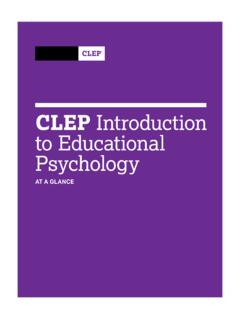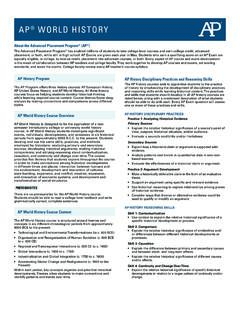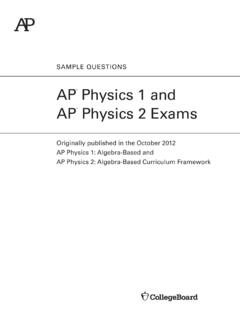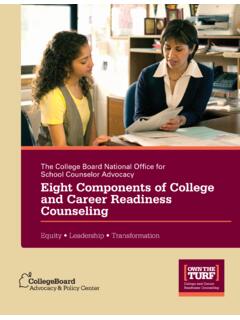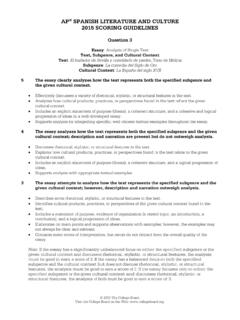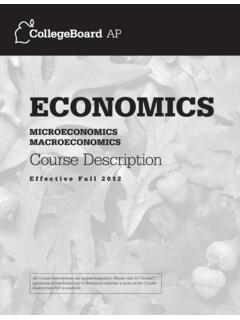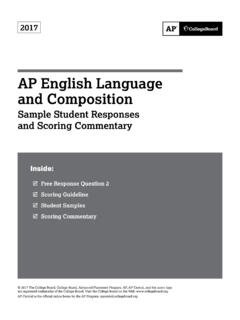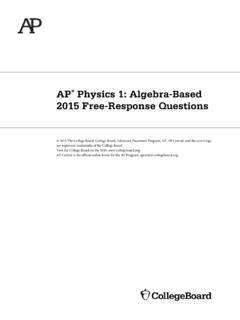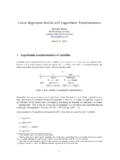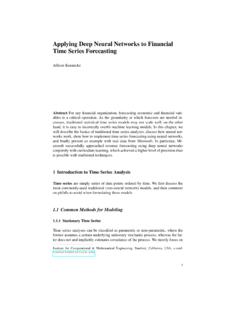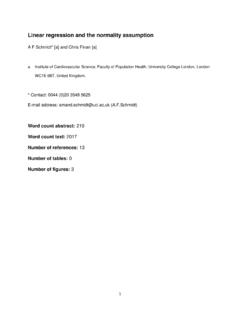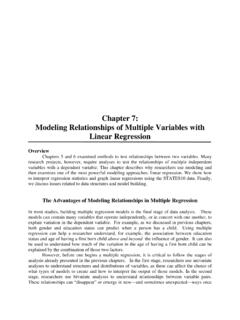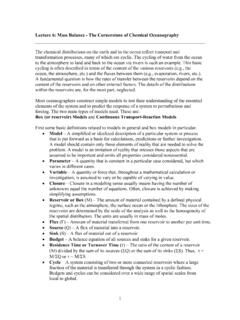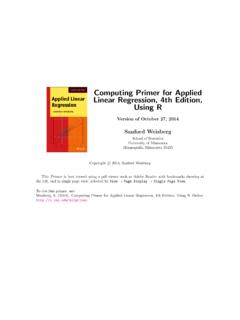Transcription of CLEP College Algebra
1 CLEP College Algebra AT A GLANCE Description of the Examination The College Algebra examination covers material that is usually taught in a one-semester College course in Algebra . Nearly half of the test is made up of routine problems requiring basic algebraic skills; the remainder involves solving nonroutine problems in which candidates must demonstrate their understanding of concepts. The test includes questions on basic algebraic operations; linear and quadratic equations, inequalities, and graphs; algebraic, exponential and logarithmic functions; and miscellaneous other topics. It is assumed that candidates are familiar with currently taught algebraic vocabulary, symbols, and notation.
2 The test places little emphasis on arithmetic calculations. However, an online scientific calculator (nongraphing) will be available during the examination. The examination contains approximately 60 questions to be answered in 90 minutes. Some of these are pretest questions that will not be scored. Knowledge and Skills Required Questions on the College Algebra examination require candidates to demonstrate the following abilities in the approximate proportions indicated. Solving routine, straightforward problems (about 50% of the examination) Solving nonroutine problems requiring an understandingof concepts and the application of skills and concepts(about 50% of the examination) The subject matter of the College Algebra examination is drawn from the following topics.
3 The percentages next to the main topics indicate the approximate percentage of exam questions on that topic. 25% ALGEBRAIC OPERATIONS Operations with exponents Factoring and expanding polynomials Operations with algebraic expressions Absolute value Properties of logarithms 25% EQUATIONS AND INEQUALITIES Linear equations and inequalities Quadratic equations and inequalities Absolute value equations and inequalities Systems of equations and inequalities Exponential and logarithmic equations 30% FUNCTIONS AND THEIR PROPERTIES1 Definition, interpretation, and representation/modeling (graphical, numerical, symbolic, verbal) Domain and range Evaluation of functions Algebra of functions Graphs and their properties (including intercepts, symmetry, transformations)
4 Inverse functions 20% NUMBER SYSTEMS AND OPERATIONS Real numbers Complex numbers Sequences and series Factorials and Binomial Theorem 1. Each test may contain a variety of functions, including linear, polynomial (degree 5), rational, absolute value, power, exponential, logarithmic , and piecewise-defined. 2 Study Resources Most textbooks used in College -level Algebra courses cover the topics in the outline above, but the approaches to certain topics and the emphases given to them may differ. To prepare for the College Algebra exam, it is advisable to study one or more College textbooks, which can be found in most College bookstores. A recent survey conducted by CLEP found that the following textbooks are among those used by College faculty who teach the equivalent course.
5 Most of these have companion websites with practice test questions and other study resources. HINT: When selecting a textbook, check the table of contents against the Knowledge and Skills Required for this test. Aufmann et al., Algebra : Introductory and Intermediate (Cengage) Huettenmueller, College Algebra Demystified (McGraw-Hill) Barnett et al., College Algebra (McGraw-Hill) Barnett et al., College Algebra : Graphs and Models (McGraw-Hill) Beecher, Penna and Bittinger, College Algebra (Addison-Wesley) Blitzer, College Algebra Essentials (Prentice Hall) Dugopolski, College Algebra and Trigonometry (Addison-Wesley) Gustafson and Frisk, College Algebra : Essentials (Brooks/Cole) Stewart et al.
6 , College Algebra (Brooks/Cole) Larson and Hostetler, College Algebra (Brooks/Cole) Lial et al., College Algebra (Addison-Wesley) Ratti and McWaters, College Algebra (Addison-Wesley) Sullivan, College Algebra Essentials (Prentice Hall) Young, College Algebra (Wiley) Rockswold, College Algebra Through Modeling and Visualization(Addison-Wesley) In addition, the following resources, compiled by the CLEP test development committee and staff members, may help you study for your exam. However, none of these sources are designed specifically to provide preparation for a CLEP exam. The College Board has no control over their content and cannot vouch for accuracy. mathlab/col_ (West Texas A&M Virtual Math lab College Algebra ) (Library of Math) (Modern States Education Alliance) Visit for additional Algebra resources.
7 You can also find suggestions for exam preparation in Chapter IV of the CLEP Official Study Guide. In addition, many College faculty post their course materials on their schools websites. 3 -1. Sample Test Questions The following sample questions do not appear on an actual CLEP examination. They are intended to give potential test takers an indication of the format and difficulty level of the examination and to provide content for practice and review. Knowing the correct answers to all of the sample questions is not a guarantee of satisfactory performance on the exam. For more sample questions and information about the test, see the CLEP Official Study Guide.
8 Directions: An online scientific calculator will be available for the questions on this test. Some questions will require you to select from among the five choices. For these questions, select the BEST of the choices given. Some questions will require you to type a numerical answer in the box provided. Some questions will require you to select one or more answer choices. NOTES: 1. Unless otherwise specified, the domain of any function f is assumed to be the set of all real numbers x for which f (x) is a real number. 2. i will be used to denote3. Figures that accompany questions are intended to provide information useful in answering the questions. All figures lie in a plane unless otherwise indicated.
9 The figures are drawn as accurately as possible EXCEPT when it is stated in a specific question that the figure is not drawn to scale. Straight lines and smooth curves may appear slightly jagged on the screen. 1. What is the remainder when the polynomial x53 12x40 3x27 5x21 + x10 3 is divided by x + 1? A. 21 B. 7 C. 3 D. 4 E. 21 2. Let a, b, and c be real numbers, where a 0 . If the equation ax2 + bx + c = 0 has two real solutions, which of the following statements could be true? Indicate all such statements. A. a > 0, b > 0, and c < 0 B. b = ac C. ac < 0 3. A science class launched a rocket from level ground. Te height h, in feet, of the rocket above the ground t seconds afer it was launched can be modeled by the function h(t) = 16t2 + 64t.
10 How many seconds did it take for the rocket to return to the ground? 4. At a certain shipping company, the cost to deliver a package depends on its weight. Te company charges a fat rate of $ for the frst 5 kilograms plus $ for each additional kilogram or fraction thereof. For this company, which of the following functions represents the cost C, in dollars, to deliver a package with a weight of k kilograms, where k is an integer greater than or equal to 5? A. C(k) = 7 + B. C(k) = 7(5) + C. C(k) = 7 + (k 5) D. C(k) = 7(5) + (k 5) E. C(k) = 7 + 5(k ) 4 x f(x) g(x) 0 9 1 1 2 5 2 1 3 3 3 8 (i + 3)(i + 2) i2 (x + 2) x 2 x 2 x52 log x3ya z 8.
